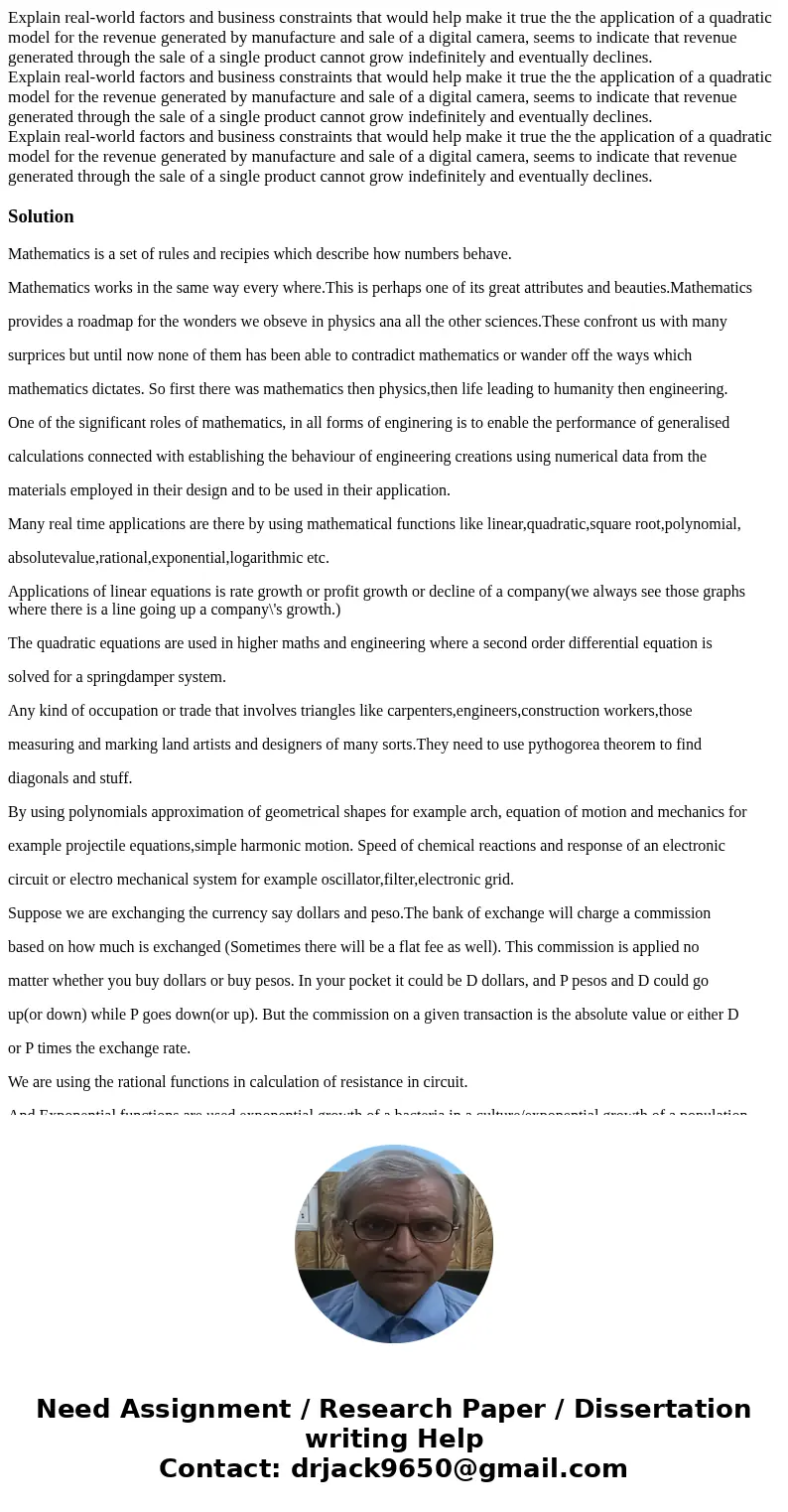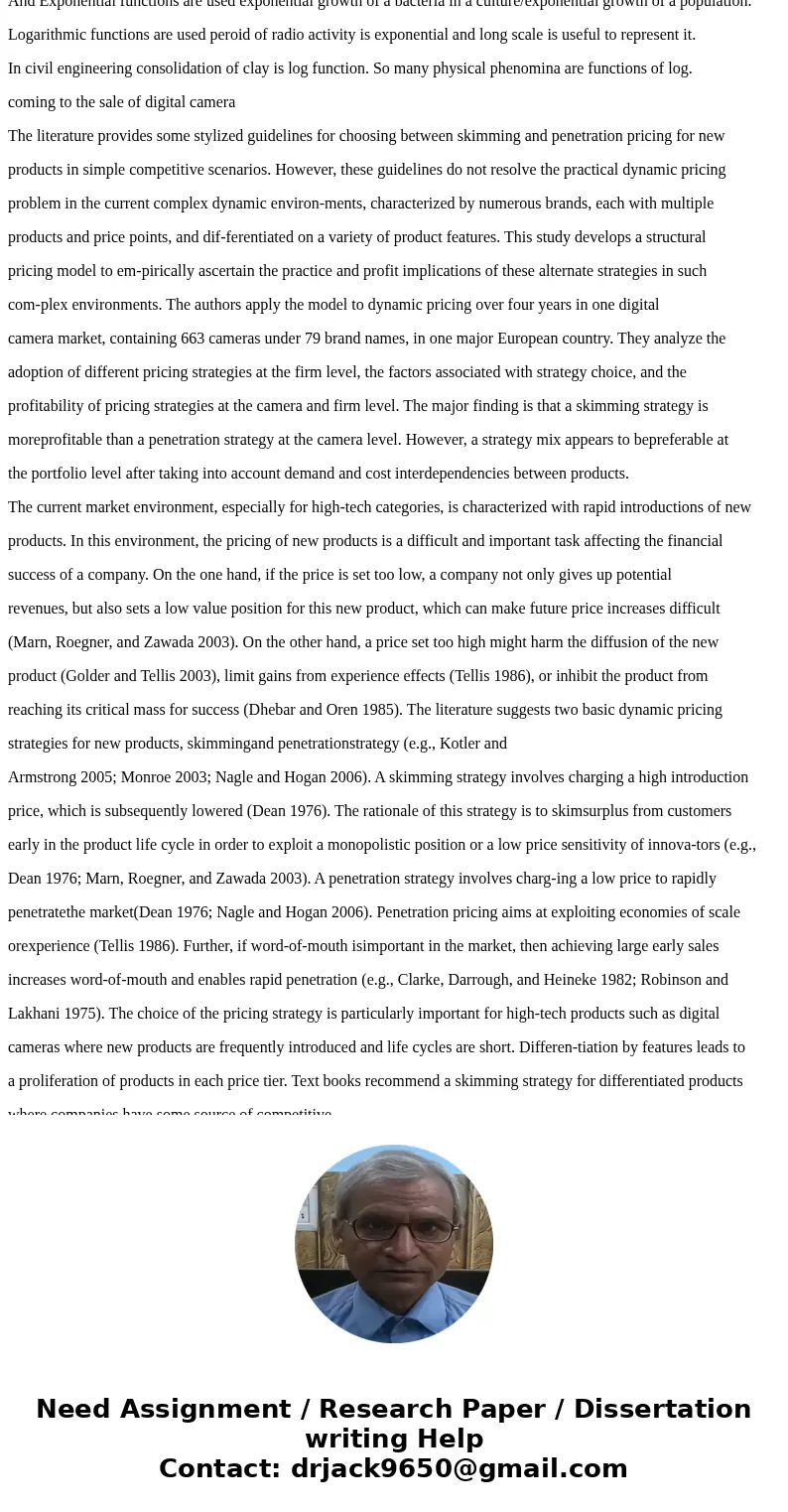Explain realworld factors and business constraints that woul
Solution
Mathematics is a set of rules and recipies which describe how numbers behave.
Mathematics works in the same way every where.This is perhaps one of its great attributes and beauties.Mathematics
provides a roadmap for the wonders we obseve in physics ana all the other sciences.These confront us with many
surprices but until now none of them has been able to contradict mathematics or wander off the ways which
mathematics dictates. So first there was mathematics then physics,then life leading to humanity then engineering.
One of the significant roles of mathematics, in all forms of enginering is to enable the performance of generalised
calculations connected with establishing the behaviour of engineering creations using numerical data from the
materials employed in their design and to be used in their application.
Many real time applications are there by using mathematical functions like linear,quadratic,square root,polynomial,
absolutevalue,rational,exponential,logarithmic etc.
Applications of linear equations is rate growth or profit growth or decline of a company(we always see those graphs where there is a line going up a company\'s growth.)
The quadratic equations are used in higher maths and engineering where a second order differential equation is
solved for a springdamper system.
Any kind of occupation or trade that involves triangles like carpenters,engineers,construction workers,those
measuring and marking land artists and designers of many sorts.They need to use pythogorea theorem to find
diagonals and stuff.
By using polynomials approximation of geometrical shapes for example arch, equation of motion and mechanics for
example projectile equations,simple harmonic motion. Speed of chemical reactions and response of an electronic
circuit or electro mechanical system for example oscillator,filter,electronic grid.
Suppose we are exchanging the currency say dollars and peso.The bank of exchange will charge a commission
based on how much is exchanged (Sometimes there will be a flat fee as well). This commission is applied no
matter whether you buy dollars or buy pesos. In your pocket it could be D dollars, and P pesos and D could go
up(or down) while P goes down(or up). But the commission on a given transaction is the absolute value or either D
or P times the exchange rate.
We are using the rational functions in calculation of resistance in circuit.
And Exponential functions are used exponential growth of a bacteria in a culture/exponential growth of a population.
Logarithmic functions are used peroid of radio activity is exponential and long scale is useful to represent it.
In civil engineering consolidation of clay is log function. So many physical phenomina are functions of log.
coming to the sale of digital camera
The literature provides some stylized guidelines for choosing between skimming and penetration pricing for new
products in simple competitive scenarios. However, these guidelines do not resolve the practical dynamic pricing
problem in the current complex dynamic environ-ments, characterized by numerous brands, each with multiple
products and price points, and dif-ferentiated on a variety of product features. This study develops a structural
pricing model to em-pirically ascertain the practice and profit implications of these alternate strategies in such
com-plex environments. The authors apply the model to dynamic pricing over four years in one digital
camera market, containing 663 cameras under 79 brand names, in one major European country. They analyze the
adoption of different pricing strategies at the firm level, the factors associated with strategy choice, and the
profitability of pricing strategies at the camera and firm level. The major finding is that a skimming strategy is
moreprofitable than a penetration strategy at the camera level. However, a strategy mix appears to bepreferable at
the portfolio level after taking into account demand and cost interdependencies between products.
The current market environment, especially for high-tech categories, is characterized with rapid introductions of new
products. In this environment, the pricing of new products is a difficult and important task affecting the financial
success of a company. On the one hand, if the price is set too low, a company not only gives up potential
revenues, but also sets a low value position for this new product, which can make future price increases difficult
(Marn, Roegner, and Zawada 2003). On the other hand, a price set too high might harm the diffusion of the new
product (Golder and Tellis 2003), limit gains from experience effects (Tellis 1986), or inhibit the product from
reaching its critical mass for success (Dhebar and Oren 1985). The literature suggests two basic dynamic pricing
strategies for new products, skimmingand penetrationstrategy (e.g., Kotler and
Armstrong 2005; Monroe 2003; Nagle and Hogan 2006). A skimming strategy involves charging a high introduction
price, which is subsequently lowered (Dean 1976). The rationale of this strategy is to skimsurplus from customers
early in the product life cycle in order to exploit a monopolistic position or a low price sensitivity of innova-tors (e.g.,
Dean 1976; Marn, Roegner, and Zawada 2003). A penetration strategy involves charg-ing a low price to rapidly
penetratethe market(Dean 1976; Nagle and Hogan 2006). Penetration pricing aims at exploiting economies of scale
orexperience (Tellis 1986). Further, if word-of-mouth isimportant in the market, then achieving large early sales
increases word-of-mouth and enables rapid penetration (e.g., Clarke, Darrough, and Heineke 1982; Robinson and
Lakhani 1975). The choice of the pricing strategy is particularly important for high-tech products such as digital
cameras where new products are frequently introduced and life cycles are short. Differen-tiation by features leads to
a proliferation of products in each price tier. Text books recommend a skimming strategy for differentiated products
where companies have some source of competitive.



 Homework Sourse
Homework Sourse